It was 1972 and we were just getting comfortable being back in combat, dropping on the forward air controller’s Willie Pete smokes (White Phosphorus rockets) in the daytime, lews (flares that burned on the ground) at night, and re-arranging the sand boxes that defined the movement routes in and out of North Vietnam. The Paris Peace talks had broken down and it was obvious that the North Vietnamese had been buying time to structure a better offensive. In various bar conversations the common wisdom was that it would be cool to be in the first strike back over the North. But after kicking the hornet’s nest, we would not want to be the second.
VA-195’s Skipper, Mace Gilfrey, called an all pilot’s meeting. Upon arriving at the ready room, he spoke with the maintenance chief and all the enlisted men disappeared. The skipper locked both doors to the ready room. Something was obviously going down. He had a bit of a worried look on his face. Then he said “we are going back over North Vietnam tomorrow morning and striking Haiphong Harbor. I am leading the first alpha strike.”
I raised my hand, and when he acknowledged me, I said “Skipper, I sure would like to be in that lead division.”
“Victor Delta, you’ve got it. Thanks.”
He then went on to explain that the Constellation was going to strike first, going after the Mig fields, and he would lead the first alpha strike from the Kitty Hawk against the air defenses, the SAM sites, flak sites, radar, etc. The plan was to soften the air defensives in the morning and then send in follow up strikes to mine Haiphong Harbor. All of a sudden I was wondering what the hell I had gotten myself into!
We were fielding three divisions (four aircraft define a division). We actually had eleven up airplanes, not twelve. Charlie Brewer and I were three and four in the lead division. Charlie’s airplane had a downing discrepancy, an AFCS (flight control/autopilot) problem. If he flew it, it would have to be in “truck” mode, which made for a sloppy responding airplane and lacked the normal “power steering” feel. Charlie had been the center on the Naval Academy basketball team and was one fine athletic specimen, as well as being a good pilot. So if anyone could handle it, he could. A fact not as well known, Charlie stood 6’ 5-1/2” tall, and had to slump and shrivel considerably to meet the anthropomorphic measurements to get into jets. He was assured of being a half inch shorter if he ever had to eject through the canopy.
The launch went as planned and we joined up with the skipper, being amongst some of the first aircraft off the deck. It took quite a while to get everyone tanked and joined up, as we had not done an alpha strike since the Fallon, Nevada, workups. We saw the circle of aircraft a few miles north as the Connie had launched about 30 minutes prior. It was a full boat operation with every asset and position filled, including MIGCAP, TARCAP, Iron Hand, flak suppression, tankers, jammers, and strike aircraft. Our aircraft were carrying a sidewinder, a thousand rounds of 20mm, and an array of five hundred pound MK82 general purpose bombs.
We were putting out some pretty good contrails and we had seen the Connie group going in. It was pretty obvious this was one big group of airplanes since you could see those contrails easily 20 miles away. When we got in to about ten miles from the coast, the radar homing and warning (RAW) gear started lighting up. Deep Sea, the air early warning folks, started broadcasting SAM alerts but after about thirty seconds just quit and went silent. It soon became obvious why. Post strike analysis proclaimed that our lead division had 28 SAMs directed at them prior to getting to the target area. What was that about the hornet’s nest?
I was mentally back in third grade as the shy little kid who always got stuck in the middle playing dodge ball. The person in the middle throws the ball and hits someone, then that person takes your place. I was not very good at it, and usually ended up the goat in the middle until recess was over. Today I envisioned the same thing, I was in the middle, except all the other kids had a ball.
We started weaving back and forth initially as was our normal tactic and moved fluidly as a flight of four. The first missiles were not terribly close and we kept our formation. Then the missiles started getting closer and the weaving became a maneuver to get out of the way. As we passed feet dry, the tempo really picked up and we were tracking multiple missiles and trying to pick the best route between them. The skipper started pulling hard to the right as one headed directly at us and Charlie obviously saw the timing was such we could not follow without swallowing the thing. He broke left and we moved rapidly away from the group. The missile was off to Charlie’s right and went off just as it passed his aircraft. It was close enough I could both hear the blast and feel the aircraft shudder from the pressure wave. The characteristic orange ball was formed from the detonation of fuming nitric acid in the hypergolic rocket fuel and looked painted on the sky. It was behind Charlie from my perspective. He started to roll slowly to the right. I saw another one coming, a bit high and figured he would quickly turn back into me, but he kept a slow turn going right. Not wanting to lose him I followed and dropped down a little in case this one went off above us. It passed harmlessly by, but now it was apparent something was wrong. Charlie continued to turn and was now ninety degrees to the strike group. I pulled to the inside and could see his silhouette slumped in the cockpit. I called to him but there was a lot of chatter on the radio, and I never got a reply. Now I assumed he might be unconscious, and spiraling out of control. I jammed the throttle forward and pulled inside his turn. If I could lift his wing, at least he would have some time to recover as we went feet wet. I closed quickly and at about a hundred feet started breaking my closure rate as I dropped to get under his wing. I wanted to time it exactly so he would be pointed out to sea.
Suddenly all his bombs came off the airplane and his head came up! I pulled hard to avoid the jettisoned ordnance. “Charlie – how do you read?”
“412 is up.”
I joined up loosely on him and flew cover while we continued to descend to about ten thousand feet and he sorted out control of the aircraft. We were trying to get feet wet and out of the SAM envelope so we could have some breathing room. As we passed the coast, I dropped some of my bombs, figuring I would keep six. If he went into the water I would need to provide RESCAP (rescue combat air patrol) until other help arrived. Once outside of the SAM envelope I joined up close and surveyed the damage.
“Holy shit, Charlie, I can see right through your vertical stabilizer!” Charlie probably did not really want to know that. And much to my embarrassment, I found out later the next hour and a half of my potty mouthing on strike frequency was piped over the 1MC for the whole ship’s crew to hear!
An assessment of the damage said he had no hydraulics except the ram air turbine (RAT). His whole emergency lights panel was lit up. The engine seemed to be running fine, but with hydraulic failure of two systems the manual said that the rudder could start destructive flutter unless he stayed at 200 knots or below so we slowed down. I pulled out the emergency flip pad in my g-suit pocket and started reading it. According to the flip pad the only way he could have control using the RAT was through using the AFCS hydraulic servos. And that was turned off. He had discovered by putting about 80 pounds of force on the stick to the left or right, the airplane would start to roll. And it took another 80 pounds to stop it. It did not appear that he had any control over the pitch except with trim. That was not going to get him aboard the ship. So we decided to try the AFCS.
As soon as he clicked the switch the aircraft rolled on its back. I hollered “Roll it out, Charlie”, but nothing was happening fast. Charlie disengaged the AFCS and then put all his might into the stick and it slowly started to roll, but his nose was going down rapidly. He could not trim in back stick until the airplane was close to upright. My heart was pounding, but I venture to guess he was swallowing his. The nose finally started to come up and we bottomed out at about 1500 feet over the ocean and started to climb back up. Whew! Let’s not do that again!
Our assessment was that he would not be able to land aboard. We switched frequencies to talk to our rep in CATTC aboard the ship. Tom ‘Moms’ Mercer was there.
“Your best bet is come along side and eject. We can have everything ready.”
Charlie looked over at me and emphatically shook his head from side to side. There was a long pause, and then he transmitted. “The plane is still flyable. I am going to take it to Danang. VD, how far is it from here?”
I pulled a map up and counted the degree lines. “About three hundred miles.”
“We’ve got plenty of gas. Moms, let ‘em know we are coming.”
We did not know how long this airplane would last. We could go around the SAM sites, and it would be another 60-75 miles in the air, at 200 knots. Or we could straight line it and go through three known SAM site rings. We opted for the quick route. I kept energy on my airplane and see-sawed over Charlie as he cruised along at 200. I kept closer to three hundred. With six bombs and my energy up I was burning lots more gas than he was idling along at 200 knots. I was not sure what I would do in case of a SAM, but if anything else came out to play, I was ready.
At about fifty miles out of Danang, we contacted approach control. They let us know we would have company shortly. I looked down at about five thousand feet and saw two Jolly Green Giants coming at us. The CH-53 was the biggest helicopter I had ever seen, but what impressed me was how fast these guys were going. They circled around as we passed over and seemed to be staying with us, one on each side. That was quite comforting. As we got within ten miles, I told Charlie I would handle the comms, and he would work on his crippled bird.
We decided to dirty up. That was a treat. As the flaps came down the airplane immediately started rolling left and no amount of stick would stop it. As the airplane slowed down from the drag it stopped rolling at about forty five degrees angle of bank. Charlie was busily trimming in back stick to keep from falling out of the sky. He slowed some more and the aircraft started rolling right. The sweet spot where it stayed level seemed to be 150 knots. Okay, we could handle that.
Danang had arresting gear on the approach end about 2500 feet down the runway. Since he had no brakes, we briefed I would use my Head’s Up Display (HUD) to give him a talk down and he would land on the end of the runway and roll into the gear. I moved up into tight formation and started looking over everything for more damage. The gear all appeared down and locked, which we expected since he blew them down with the emergency system. The wheels and tires all looked good, no obvious strut or actuator leaks. Maybe we were getting some luck. The approach was rock stable and Charlie guided the stricken A-7 right to the end of the runway while I flew about a hundred feet above him.
As I looked out on final, there were five C-141’s on the parallel taxiway, obviously waiting for the emergency to recover so they could launch. What really caught my eye, though, was that the bunkers along the parking apron and taxiway were full of people. It looked like about three thousand people were sitting on top watching us come in! They had almost two hours warning, but I thought this vulture’s row thing sure did not seem very prudent.
The A-7E touched down and immediately started heading toward the side of the runway.
“Wave off! Wave off!” It was obvious from my perspective he was not going to make the arresting gear.He pulled the trim aft and added full power. The response was agonizingly slow. The nose just started to lift as the aircraft was leaving the concrete. He was bore sighted on the MOREST arresting gear motor. The bird finally lifted off and it looked like the landing gear straddled the MOREST as he flew over it, probably not more than ten feet off the deck. The aircraft started rolling right toward the waiting C-141s. He passed over the second one in line at about 25 feet, and I made a mental note that there did not seem to be anyone in the cockpit! At least we had missed the tails. Now we were pointed toward a large mountain just south of the base.
“Lower your nose, Charlie, we need to come left.”
The aircraft picked up some speed and started its roll to the left. I called the tower.
”We need to go back out and try it again, this time we will try to land just short of the arresting gear.” I figured at this point I did not need to do a RESCAP. “Tower, can I jettison ordnance on safe in the water abeam the field.”
“Standby….We don’t see any boats out there. If it looks clear, go ahead.”
I checked the arming switches on safe, and set the intervalometer to six, and manually pickled the bombs off. As was often the case with the mechanically fused bombs, an arming wire probably hung in the rack and one weapon went off live on impact. By the time we taxied in, the area was full of little boats picking up the dead fish.
We lined up again at about six miles, and got stable. The culprit was now evident. The right main had looked fine, but apparently had been punctured with shrapnel and had no air in it. This time I used an aim point that would just allow the nose to fall through and hopefully the hook would catch. We made our approach and I glanced down out of habit at a half mile. Four hundred pounds of gas.
“Tower, 402 will need an immediate landing on the left at the completion of this pass.”
“Roger.”
Once again Charlie flew a rock solid approach, hit the deck about a hundred feet prior to the gear, and had started to drift right by the time he got there. But the hook caught and he was on deck. One airplane saved.
“Tower, Chippy 402 for an immediate downwind for landing on the left.”
“Roger 402. Spooky 47, extend your downwind.”
Spooky was an old World War II DC-3 that they had mounted mini-guns and a star scope on for night work on the Ho Chi Minh trail. They flew the pattern at about 90 knots.
“Tower, Spooky 47, that is a negative, we are low fuel at this time.”
Okay, I don’t have time for this. “Spooky 47, you have an A-7 behind you with armed guns.”
“Spooky 47, extending downwind.”
Okay, Tom, now is not the time to lose concentration. You only get one shot at this. And there are about three thousand people watching this landing. We need to show them what a real Navy pilot can do. I flew a flawless approach. They had a mirror optical landing aid on the runway and the ball never wavered. Unfortunately, with three hundred pounds of gas, although the A-7 touched down at exactly where I aimed it, it bounced ten feet into the air and floated for about 500 feet. Somebody, please, just bury me right here!
I taxied up to the revetments as they towed Charlie’s airplane in from the right runway. They had given him a ride on the tug and a plane captain was riding in the cockpit. Charlie stood and watched the aircraft as I came up. The plane captain climbed down and handed Charlie his helmet bag. He reached for it with his right hand, and it summarily dropped rudely on the deck. He had absolutely no strength left.
Now, having told this story for over 40 years, there could have been some things I forgot. I thought for sure Charlie and I consume two cases of beer while discussing our premarital sex lives in the Danang BOQ that night. But upon reading my version, Charlie recollected it a bit different. And added some interesting bits that I forgot, and a few he made up! I never owned a 44 magnum, but might have to after reading this! Here is his version:
This is Charlie with a post-script: DeMarino refueled hot and flew back to the Kitty Hawk, leaving all those stunned fish to the sand pans. Funny that I missed the part about the floating fish. Tom was a man after my own heart as he always carried a .44 magnum (or various other firearms from his considerable collection) under the driver’s seat of one of his Saabs, the only car he would own. He was once approached at a red-light in Watts by a hood who greeted him as a “MF” and threatened to take him out if he didn’t hand over his wallet. Tom swiftly stuck the .44 mag in the accoster’s face who then executed a quick retreat. I recall Tom telling me the story with a grin of confident satisfaction on his face, a common expression of his throughout our adventures in the Gulf. He had a great handle on all the aircraft operating systems and I was privileged to have him on my wing that day. I struggled with some amnesia after that strike (couldn’t remember much about prior missions when before I could recite every detail) but think Tom may have also been with me soon thereafter when Admiral Clary pulled me out of bed around 0100 the morning of the mining of Haiphong Harbor and ordered me to plan and lead a diversionary alpha strike just ahead of the mining mission. As we went feet dry a gaggle of MIGs popped up through the overcast to the North of us and one of our DDG’s in the Harbor shot down the lead. The rest turned and ran. We never engaged the MIGs but proceeded to our assigned target. The miners reportedly went in and out undetected without a shot being fired. Whether the Diversionary Strike was instrumental in that I don’t know.
The base assigned me to a bunker that night due to anticipated VC mortar attacks, which did come in. As to aircraft damage, we would later discover there were thousands of holes in the aircraft from nose to empenage, some tiny pin holes, the largest a ~39″ x 14″ oval immediately behind the cockpit near the top of the fuselage. Many of the tiny pieces of shrapnel penetrated the wire bundles, making it almost impossible to diagnose. I had the ignominious honor of later flying its first test flight. I don’t honestly know if the bird was ever fully rehab’d. The following morning a P.O.1st class was sent into Danang from the Kitty Hawk/squadron on the COD to inspect the damage and help assess whether Chippy 412 was flyable. (I was later able to help him with an affidavit to prove he had been in country so he could get help from the VA for Agent Orange type of cancer.) He was up in the cockpit when I entered the hanger approaching. When he saw me he was immediately animated, yelling “Hey Mr. Brewer, you sure are lucky you didn’t eject!” When I climbed up to see what he was talking about he showed me two things: shrapnel from one of the SAMs had “welded” the steel seat to the steel rail on which the ignited rocket seat slid. “If you had ejected you would have fried in the cockpit.” And then he said “Even if you could have gotten out of the airplane manually, you would not have survived a jump because the chute would never have blossomed,” showing me where shrapnel had ripped through my parachute just below my neck, severing most of the cords.
Sometimes we make inexplicable decisions (mine to try save the airplane and parrying LCDR [later 1st skipper of the Carl Vinson,… Admiral] Mercer’s directive to eject and not make any attempt to land on the ship), following a still small voice that we don’t understand except in retrospect. That strike was another “but for the Grace of God.” [“Under his wings you will find refuge;… you will not fear the terror by night or the arrow that flies by day…” -Psalm 91] As in other life experiences, I got better than I deserved.

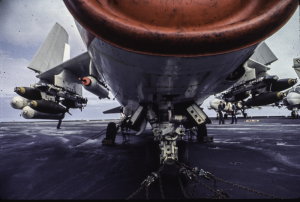
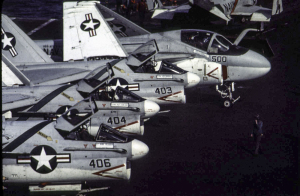

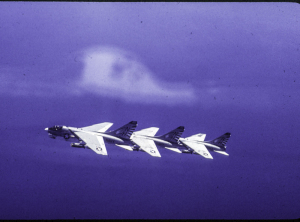
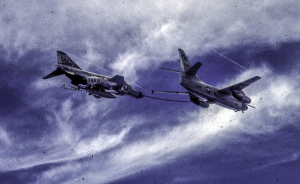
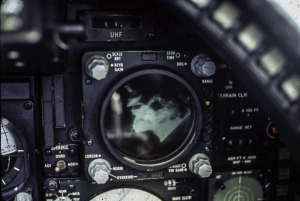
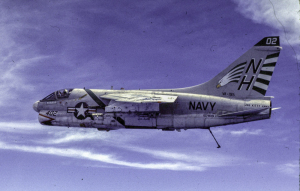
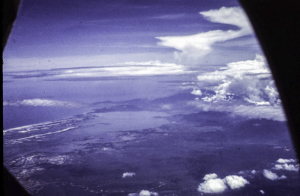
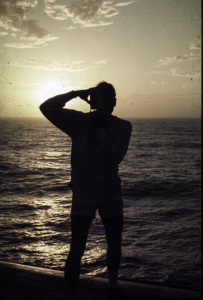
3 responses to “Opening Day”